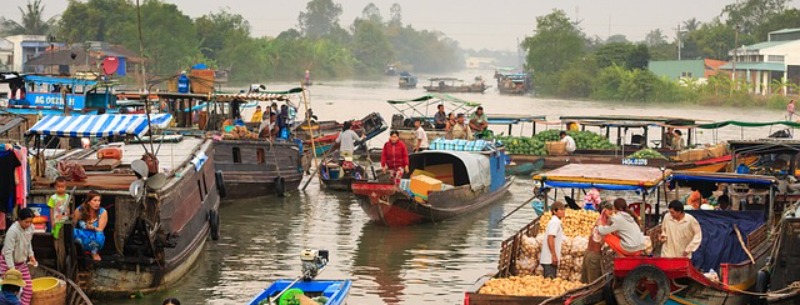Southeast Asia has long been a standard on the backpacking circuit and you’ll be hard pressed to find a country that doesn’t have its share of well worn boot tracks between hostels and suggested highlights. Laos is no exception. It is, perhaps, less traversed than Thailand and Vietnam, which sandwich its long narrow countryside between them, but it’s far from untouched. If you flip through your Frommer’s Southeast Asia you’ll find lots of recommendations for the ballooning north of the country, but the further south you go, the thinner the segments in the books.
To me, this is a good sign; anytime the guidebooks haven’t made a region a priority, it’s an indicator that there are still adventures to be had and some off the beaten path discoveries to be made.
If you’re headed to Laos, by all means, hit the northern highlights, but if you’re interested in seeing a less-trodden Laos, getting completely away from English speaking tour guides, and seeing some things most of your buddies on the backpacking circuit haven’t, may I suggest a self-guided tour down the Mekong River?
Start In Pakse
Pakse is a river town, about five hours south of Savannakhet, which is where you’ll have either arrived by bus from Vietnam, Thailand or the north of Laos. It’s a fair sized place that is fun to wander. The river walks are especially nice. There are a couple of good wats. Pakse is a great place to just wander, people watch and get a window into urban Laotian life. You’ll find the people open and friendly and you won’t have any trouble finding authentic local food!
Treat yourself in Pakse and stay at the hotel that is the refurbished palace of the last prince of Laos. The hotel is very nice by Laotian standards, but not spectacular. It’s fun to wander the grounds and explore the long hallways of the open air building. Be sure to wind your way all the way to the top of the building and go into the little ballroom perched at the apex. It has a spectacular painted round ceiling with characters from Laotian mythology running around the edge of the room.
Public river boats used to be the only way to travel to the south of Laos when the roads were disreputable and buses unreliable at best. Depending on the time of year you’re there, you may find the public boats running. During monsoon they run sporadically at best and often not at all as people have traded the inexpensive buses for boats on a swollen river. If there are no public boats running, you can still hire a private boat (look for some other travelers who are wanting to do the same, and make arrangements to head down the Mekong. You’ll see signs around town for boatmen, or, head to one of the docks and ask around.
Head to Champasak
It’s a beautiful couple of hours down the brown-green Mekong river, surrounded by walls of jungle, punctuated by little groupings of fishing families on the shore. Naked children swimming, women washing clothes, men in boats fishing, or collecting the floating drift wood in their long reed shaped barks provide plenty of visual interest as you chug south. It’s easy to imagine how life has unfolded for generations on this great river, largely untouched by the wars that raged in the surrounding countries, an economy built around and dependent on the river.
Champasak isn’t even a one horse town. There are a handful of guest houses. If you need internet, the only choice is Inthira, it’s the nicest place in town, but there are other choices. You’re here to see the Wat Phou complex about 10 km from town. You’ll need to hire a tuk-tuk to get there, or rent bicycles if you’re energetic. It’s a good hike and a steep climb when you get to the ruins, but the view from the top is spectacular. If you’re headed to Angkor Wat, later in your trip, these ruins are a great set to see first, as they were built by a similar people group.
From Champasak head downstream. You won’t have trouble arranging a boat for the next leg of your journey from in town.
Don Khong Island
There are several islands in southern Laos, where the Mekong widens before it tips over the falls into Cambodia, approximately 4000, in all. Many of them are tiny and uninhabited, but there are a few that are home to small communities and make excellent places to kick back for a few days, slow down, and catch a glimpse of rural life in Laos at its own pace.
Don Khong is one of our favorites. You’ll find several guesthouses in the main part of town, a lovely old wat, and bicycles for hire along the waterfront street. Rent a bike and ride the flat island. You can do it all in a day, or you can break it up into two loops, the northern half of the island being the longer loop and the southern half the shorter.
Expect to see water buffalo wallowing up to their armpits in wet fields, families tending rice paddies and children selling things roadside. Everyone waves and says, “Hello!” If you’re lucky, you might even get invited into the field to help transplant the new rice plants, or walk behind the big, rattling rice cultivator with a farmer.
Spend a few days. Slow your pace. Open your eyes. Meet the mighty Mekong where she wanders.
